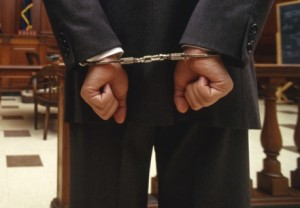
SNOW HILL — A Selbyville man, characterized by prosecutors this week as “perhaps the most dangerous driver” in Worcester County, was found guilty of driving while impaired this week and sentenced to one year in jail for his 11th drunk-driving arrest.
A Worcester County Circuit Court jury deliberated for about a half an hour on Wednesday before returning a guilty verdict for driving while impaired for Gerald Lusby, 42, of Selbyville. The jury had the option of convicting Lusby on the lesser driving while impaired charge or driving under the influence, a more serious offense that carries stiffer penalties in terms of jail time, fines and probation.
What the jury did not know and could not have known when it went back to deliberate is that it was Lusby’s 11th drunk-driving arrest in a span dating back to 1991. After the jury returned the guilty verdict for driving while impaired, Executive Assistant State’s Attorney William McDermott made that information available just prior to the sentencing phase.
“He is perhaps the most dangerous driver Worcester County has,” McDermott told Judge Thomas C. Groton prior to sentencing. “The minute he’s incarcerated, Worcester County is a safer place, which is why we’re asking for the maximum of one year.”
Lusby’s defense attorney Richard Parolski told the judge a maximum jail sentence left no room for addiction treatment and other counseling for his client and urged a lesser sentence with provisions for treatment included. However, Groton, after hearing Lusby’s litany of priors, was in no mood for leniency.
“He has demonstrated that is never going to happen,” he said. “I have no confidence he will ever do that. The only thing to do is keep Mr. Lusby off the road for as long as possible.”
What appeared on the surface to be a rather mundane drunk-driving trial lasted around three hours as McDermott and Parolski sparred over the nuances of suspected drunk-driving stops and subsequent roadside tests. The OCPD officer who pulled over Lusby and ultimately arrested him was on the witness stand for hours as Parolski attempted, successfully to some degree, to punch holes in the officer’s version of the facts of the case.
In his official statement of charges, the officer said he observed Lusby heading south on Coastal Highway in the area of 130th Street in the early morning hours of Feb. 19, 2014. The officer said Lusby was traveling in his mini-van in the center lane, but drifted over the far right lane and straddled the lane marking for the bus lane. According to the officer’s report, Lusby then veered back across the southbound travel lanes and straddled the line between the middle and far right lanes, which is when he affected his stop in a parking lot at 127th Street.
On this phase of the narrative of the case, Parolski hammered the officer on the distance he was behind Lusby, the length of time he straddled the various lane markings and the degree to which he straddled the lines. The officer testified each time Lusby straddled a lane marking, his vehicle was halfway in one lane and halfway in the other with the lane markings down the middle of his vehicle.
Parolski also pointed out an apparent flaw in the officer’s two separate narratives of the case. In the statement of charges, the officer said he began observing Lusby in the area of 130th Street. However, in the DR-15 Advice of Rights, which outlines a suspect’s options for taking or not taking a breath test after an arrest, the officer reported he began following Lusby at around 133rd Street, or three blocks different from the statement of charges.
Also in terms of the statement of charges, Parolski pointed out the officer’s narrative included names of suspects different from Lusby on multiple occasions. For example, the statement said Lusby did this, or Lusby did that, but in another paragraph, it said Jones did this or that. The officer explained he used a prior statement as a template for his new report on Lusby and the name differences were merely clerical errors that weren’t corrected.
Once the officer stopped Lusby, he asked for the suspect’s license and registration. Lusby allegedly told the officer his license was in the center console, but then reached into his pocket. The officer testified Lusby appeared confused and intoxicated, and when the suspect reached into his pocket, the officer unholstered his gun for safety. According to the testimony, Lusby produced an American Express credit card and presented it to the officer as his license.
Parolski also went on the offensive on nearly every aspect of the field sobriety tests, which included the heel-to-toe walk, the stand on one foot and the eye test. The attorney also questioned the officer extensively on Lusby’s attempts and the counting and alphabet tests. After the testimony, Parolski told the jury each apparent flaw in the stop and arrest combined to place reasonable doubt in the case. It is uncertain if the jury bought his attempts to punch holes in the state’s case, but it did return with a guilty verdict for the lesser DWI charge.
